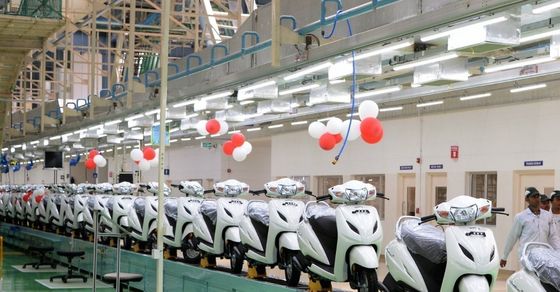Make in India: Have we made it?
AUG 15 2021, 00:05 ISTUPDATED: AUG 15 2021
Objectively speaking, the performance of the manufacturing sector has been far from satisfactory.
Since 2014, the index of industrial production has scarcely registered double-digit growth, contrary to the target of 12 - 14 per cent growth per annum.
Data from the Centre for Monitoring Indian Economy shows a deceleration in the manufacturing sector that is even more pronounced than the economy.
As opposed to generating 100 million jobs, a report by the Centre for Economic Data and Analysis of Ashoka University shows that India actually lost 10 million jobs in the four years between 2016 - 17 and 2019 - 20.
Taking the pandemic into account, the sector lost close to 40 per cent of its jobs (24 million) when compared to 2016.
And the share of manufacturing in the economy — which has never crossed 18 per cent historically — which stood at 14.9 per cent in 2018 - 19 (other years are affected by the pandemic), much lower than our neighbouring countries like China (29 per cent), Bangladesh (18 per cent), Vietnam (16 per cent), Thailand (27 per cent), Indonesia (19 per cent) and Philippines (19 per cent).
So why did Make in India never take off in a big way?
Other initiatives
The Modi government did do a lot of things right. Several other focused programmes — Skill India, Digital India, Start-up India — were brought in to supplement the initiative and boost employment.
Over the years, wide-ranging reforms have also been brought in.
In 2016, there was the Insolvency and Bankruptcy code for the time-bound resolution of bankruptcy, proposing to reduce time taken to dispose insolvency case from 4.8 years to 270 days; the long-pending Goods and Services Tax was implemented in July 2017; four industrial labour codes were passed (although with diluted provisions), simplifying and replacing over 29 existing central labour laws.
The government has also taken steps to strengthen the Intellectual Property Rights ecosystem by reducing red tape, digitising the process and appointing new officers to foster innovation.
Even during the pandemic, the government’s special economic stimulus package provided some respite to a ravaged economy.
But the targets set out under Make in India were overtly ambitious and India does not seem to have the capacity to undergo such a drastic transition to manufacturing in such a short time-frame.
The initiative also set out to cover a large number of sectors, including those we do not have a comparative advantage in.
With its vast demographic advantage, India should focus on developing labour-intensive sectors, like tourism, gems and jewellery or the hospitality sector. But the Economic Survey 2020 - 21 reports that around 40 per cent of India’s exports consist of technology-intensive goods.
Compare this with neighbouring Bangladesh, where 90 per cent of exports consists of labour-intensive products like textiles, footwear and readymade garments.
The positive impact of Bangladesh’s garment industry in improving social indicators and employing a large number of workers, especially women, is well-documented.
While the FDI reforms have led to a large inflow of foreign funds, the overt emphasis on foreign capital and global markets to develop the domestic manufacturing sector was not wholly justified. Rather than soliciting investors, a competitive enough market would have attracted them.
Poor infrastructure
While the government has focused on developing infrastructure, especially roads and port connectivity through programmes like the Bharatmala and Sagarmala projects, the pace of implementation remains slow.
While state-of-the-art infrastructure is essential for such a drastic shift to manufacturing, the quality of the existing facilities remains poor.
Just one statistic highlights the gulf between India and China. In 2018, India’s air freight transport stood at 2,704 million tonne-km, compared to China’s 25,256 million tonne-km.
Though the Central government has been proactive in pushing through reforms, doing business continues to be difficult on the ground.
Reforms at the higher echelons of the bureaucracy have not been reflected on the ground and dealing with government officers at the grassroots remains the age-old challenge it has always been.
The lack of coordination between the state and the Centre on many issues often means companies pull out after they have expressed interest in a setting up a project.
Labour laws at the state level continue to be complicated, though Rajasthan has introduced a few major labour law reforms making the rules more flexible. A few other states are also moving in the same direction.
‘Assemble in India’
The ‘Assemble in India for the world’ (for the manufacture of network products like adapters, routers and access points), which the Economic Survey 2020 predicted would create 40 million jobs by 2025, (provided India increased export of these products from 0.6 per cent to 6 per cent by 2030) was a promising initiative.
It is stymied by a protectionist regime and inverted tariffs (increased tariffs on inputs and intermediate products when compared to the final goods) which disincentivise assembly manufacturers.
Large-scale reforms like demonetisation and GST, though carried out with good intentions, disrupted the economy.
Other developments in the domestic economy like the twin balance sheet problems (worsening balance sheets of both companies and public sector banks in India), the lack of aggregate demand (slowdown of consumption, investment and exports) and the Non-Banking Financial Company crisis have also been a drag on growth.
External factors have not helped as well.
While the USA-China tariff war and rise of protectionists were pulling down India’s exports, the pandemic knocked out both the slowly progressing manufacturing sector and the economy.
India has over 900 million-strong workforce with an average age of 27 years. By 2050, the average Indian will be over 37 years old.
Our demographic advantage won’t last forever. The next 30 years will be crucial if India is to script a growth story and remain in contention as a nation to be reckoned with on the global stage.













